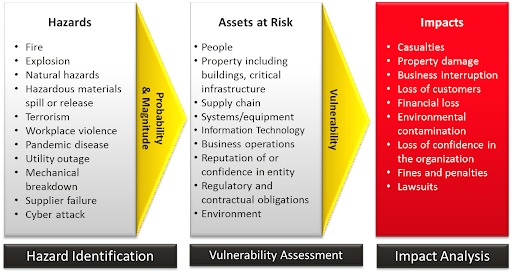Incidents such as extreme weather, man-made disasters, and pandemics not only affect County residents but can also affect local businesses as well. Communications can be stifled, employees may be unable to work , and normal systems that organizations rely upon can be affected. Small businesses are especially vulnerable to disasters, with 43% of businesses impacted by a disaster never re-opening and 29% of businesses closing permanently within two years of a disaster. Businesses that create and implement a Business Continuity Plan are more likely to be prepared for a disaster and are more likely to recover and remain open after a disaster.
Creating a business continuity plan is simple and can be easily implemented for all types of businesses. The following 5 steps provide an overview and resources for businesses to develop a continuity plan:
Complete a Risk Assessment and Business Impact Analysis
A risk assessment is the process used to identify potential hazards and analyze what could happen if a hazard occurs. There are numerous hazards to consider, some of which have been detailed in our county Hazard Mitigation Plan update. The majority of your planning efforts should focus on the high-impact, high-likelihood events.

After identifying potential risks, conducting a business impact analysis (BIA) will analyze at how these threats will impact your business’s essential functions. An essential function is a core activity of a business which, usually, is incorporated in the business mission statement. Review your business plan, standard operating procedures, organizational chart, and mission statements to determine which business functions cannot be suspended for more than 30 days and which ones need to be restored within 12 hours for your business to continue. These are your essential functions.
Resources:
Environmental Protection Agency Information on Risk Assessment
Identify Vital Resources and Key Personnel
Records, systems, and equipment are vital to the operations of most businesses. Identifying and protecting those resources can save valuable time and money after a disaster strikes, when resources and replacements may be hard to find. Look at your essential functions and identify the records, systems, and equipment related to those functions. Back up vital records and equipment offsite and make a “go-kit” for vital resources in case you have to evacuate the building.
Other resources to identify include neighboring businesses. Working in coordination with neighboring businesses and building owners can help avoid confusion and gridlock in the case of an emergency. Collaboration is especially useful for small businesses with limited resources.
Some vulnerabilities to your vital resources and records that you may want to consider include fire and water damage, cyber-attacks, power failure, vandalism, and deterioration over time. Employees also one of the most vital resources of your business. Some may not be able to come to work after a disaster, so you should identify the staff members that your business needs to complete its essential functions. A list of these key personnel and their contact information should be included in the business continuity plan, and consider cross-training when possible.
Develop a communication plan with your employees, suppliers, and customers
Now that you have developed a Risk Assessment and BIA, utilize that information to evaluate how each hazard will affect your normal means of communication. Estimate how long systems can be down if a communication failure occurs and identify alternate modes of communication. Redundant communication systems to evaluate include landlines, VoIP phone systems, cell phones, servers, internet accessibility, website accessibility, among others. Emailing may seem like an easy alternative, but you may not have access to email at your business during an emergency.
Resources:
Open for Business® Know Your Employees Worksheet - Institute for Business & Home Safety
Make and Implement the business continuity plan
Once a business’ essential functions have been identified, risks assessed and scored, and the business’ vital resources are identified, the business can develop strategies to protect those resources. Businesses should make a written plan that covers disasters that are likely to occur in Anne Arundel County. Generally, the County supports an “all-hazards” approach to planning. For example, a business would have a plan if local public transit ceases operation, regardless of the reason for public transit disruption (snow, hurricane, etc.).
Under the business continuity plan, businesses should designate a primary crisis manager and create an order of succession in case the primary crisis manager is unavailable. The primary crisis manager should be an individual with day-to-day decision-making authority in the business that is intimately aware of the business’ policies and procedures. The order of succession should clearly state who would assume responsibility if the primary crisis manager is not present. The plan should clearly note secondary locations for operations, if any. There are some common issues that all businesses should consider while undertaking continuity of operations planning, such as weather emergencies, property or equipment destruction, public health concerns, and workplace violence. However, every business is unique, so a plan should be individually tailored to each business.
Implementing the plan includes ensuring that your employees are trained in their roles during a disaster or emergency, and are prepared to take on roles and duties of those they may succeed in a disaster.
Resources:
Ready.gov Business Continuity Plan Template
Open for Business Toolkit - Institute for Business & Home Safety
Review, Evaluate and Modify the plan
Exercising your plan can ensure your employees are familiar with the plan and that it can be implemented in an emergency. To exercise your plan, create a scenario and talk it through with your employees. For example, what would happen if a flood affected the roads near your facility, or power is cut off to your facility for an extended period of time. Test the capabilities of your organization by addressing questions such as: Do employees know where the shelter location is at work? Are they following the role that they were assigned in training? Would this be a good plan if this event actually took place? Be sure to go over any suggestions anyone has and ensure the procedures are updated and adapted to reflect the lessons learned.
Resources:
Ready.gov Testing and Exercises
Additional Resources:
Anne Arundel Economic Development Corporation Disaster Recovery Assistance
American Red Cross Ready Rating
U.S. Chamber of Commerce Foundation Resilience in a Box Program
Business preparedness resources from the U.S. Small Business Administration
Do 1 Thing Emergency Preparedness for Business
Federal Communications Commission Cyberplanner
FEMA's Business Preparedness Education Campaign
Maryland Emergency Management Agency (MEMA) Preparedness Resources for Businesses
FEMA Training for Community-Based Organizations: Organizations Preparing for Emergency Needs (OPEN)

Request a Presentation
The Office of Emergency Management (OEM) offers emergency preparedness presentations for our community. To request a presentation, please fill out the submission form and a member of OEM team will be in touch to coordinate a presentation.
